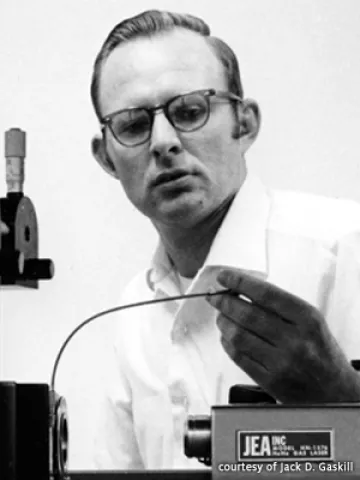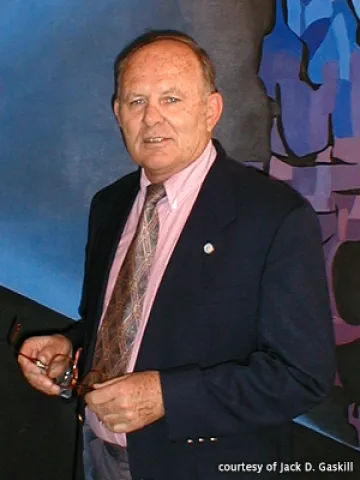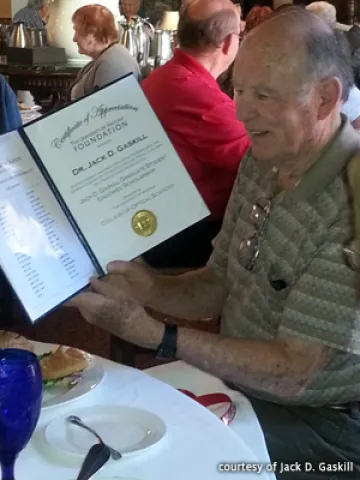Etendue: Jack D. Gaskill

Welcome to Etendue, featuring interesting and accomplished individuals known for their leadership and contributions both with their careers and the College of Optical Sciences, in their own words. (For a similar view on the college’s best and brightest – our students – please check out Another Wavelength among our Students in the Spotlight.)
This month, we hear from OSC Professor Emeritus Jack D. Gaskill.
Where are you from?
I was born and raised in Fort Collins, Colorado. I lived on a small acreage with my parents and three brothers, where we raised chickens, rabbits, horses, cows and sheep. I served as a horse-riding delivery boy for the Denver Post during the blizzard of 1949.
How did you get interested in optics?
I attended Colorado A&M College for three years and 11 months. Yet, in May of my senior year, the college became Colorado State University. My degree was a B.S. in electrical engineering.
I then worked at Motorola in Scottsdale, Arizona for a few months before reporting for duty with the U.S. Air Force. In the Air Force I served as an instructor pilot. I was also a classroom instructor for the subjects of flight planning and air traffic control.
In 1963, I left the Air Force to study transistor circuit design at Stanford University. However, when I arrived on campus I was informed that my assistantship had been moved from the electronics lab to the laser lab. I was very disappointed at first, but two weeks later I "saw the light" and have been in optics ever since.

Describe your career.
As mentioned above, I "fell" into optics rather than choosing it. What a lucky fall! I was also lucky that Joe Goodman became my advisor (at Stanford) and helped me choose holography as my field of study.
I would like to mention that, over the years Joe Goodman placed me near the top of his student lists. To illustrate, he kept pointing out that I was his second student and his first mistake. Let's move on.
The University of Arizona was starting a graduate program in optics just as I was finishing my Ph.D. at Stanford in 1968. I was given a position as Assistant Professor of Optical Sciences in the program.
After arriving at the University, I continued my research in holography and presented a course in applications of Fourier theory in optics. I also became involved in the administrative activities, serving as Associate Director for Academic Affairs, and was instrumental in establishing the Industrial Affiliates program at the Optical Sciences Center.

Why is staying in touch with OSC important to you and how are you involved?
I retired from the University of Arizona in 1999 - and continue to be retired.
While I still enjoy occasional visits to the College, I really miss the daily interaction with the students, staff and faculty.
I continue to teach my short course in Fourier Optics at one-to-two SPIE conferences each year, which allows me to still see many of those that I met during my years at OSC.
[Editor’s note: In 1999, Jack and his wife, Sandra, commemorated his retirement from teaching by contributing a very generous gift to be offered as undergraduate student scholarships in optical sciences. Many alumni followed his example by also making contributions which then endowed the Jack D. Gaskill Undergraduate Scholarship. In 2015, colleagues, friends and alumni decided to further honor Jack for his contributions as a professor, adviser, mentor and administrator by also establishing the Jack D. Gaskill Graduate Student (FoTO) Scholarship.]
Share your single best OSC experience.
I had many great experiences, but my single best experience while at OSC was when I was elected President of SPIE for the year 1995. As SPIE president, I was given opportunities to visit other universities and industrial companies that were involved in optics, and I traveled overseas to Europe and Asia. These are all places I might not have visited otherwise. I was also introduced to some incredibly accomplished individuals that I might not have met otherwise.
Name one neat fact about you.
My wife, Sandra, and I live in Tucson for about six months each year; in Pinetop for another five months; and then travel for about two months. That makes for a really long, wonderful year.

